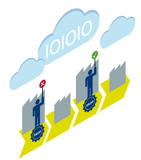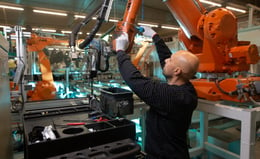Why You Should Integrate Transportation Forecasting into Your SCM
Brian Hoey - January 07, 2021

 Even before the pandemic struck, 2020 was projected to be a complex year for freight. Ambiguity in the American truck labor market—an industry which has complained of labor shortages for many years—caused confusion about what would happen to capacity and whether those changes would exert real cost pressures. By June, volumes were way above previous years’ levels, and tender rejections were soaring. The result? Businesses that used to be able to rely on easily-attained freight capacity at workable prices often find themselves scrambling to move their goods from Point A to Point B at any price.
Even before the pandemic struck, 2020 was projected to be a complex year for freight. Ambiguity in the American truck labor market—an industry which has complained of labor shortages for many years—caused confusion about what would happen to capacity and whether those changes would exert real cost pressures. By June, volumes were way above previous years’ levels, and tender rejections were soaring. The result? Businesses that used to be able to rely on easily-attained freight capacity at workable prices often find themselves scrambling to move their goods from Point A to Point B at any price.
Over the past year or so, change in many sectors has been non-negotiable. In supply chain management in particular, everyone from well-established enterprises to new entrants into the logistics or manufacturing space has had to adapt to changing consumer expectations and a minefield of potential pitfalls and disruptions—from closed-off trade routes to sole-sourced suppliers impacted negatively by the virus. Even as the virus itself (hopefully) abates, many of these changes are here to stay.
So, how are supply chain businesses supposed to cope with this new normal? One key strategy is to integrate transportation forecasting into your existing planning and technology stacks. In this piece, we’ll give you four good reasons why that might be the case.
1. Freight Capacity Is Volatile, and Competition Is Increasing
Like we alluded to above, tender rejections are on the rise. Why? Because more goods than ever need to pass through various supply chain channels, and 3PLs, shippers, and others are in a position to be picky about what freight they actually want to take on. For companies trying to ship larger and more unwieldy cargo, or who are slower to reserve capacity, this can quickly become an issue. At exactly the same time most businesses are looking to optimize logistics costs, increased competition is forcing companies to shell out extra money for premium freight on shipments that would have been tendered successfully in previous years. This status quo is risky and, ultimately, untenable.
2. Waiting for Real Orders to Emerge Is Too Slow
Okay, if the current transportation environment is so unfavorable to the traditional way of doing things, especially for manufacturers of larger goods like automobiles and large appliances, why do some many businesses stick with it? The short answer is that most transportation management systems require you to have real orders coming in before you can book freight. This means that you’re effectively stuck with the traditional booking window of 1-2 days after an order comes in. Because this window is so narrow, you’re more or less stuck with whatever options you have at the exact moment the order comes in, no matter how unfavorable they are. The only way to break out of this cycle is to expand that window for booking capacity beyond the existing 1-2 day window; in this way, you can monitor prices and availabilities over time, and book the right price in the right lane when it comes available.
To do this, you’d need to be able to book based on forecasted orders, rather than real orders. Again, most TMS solutions aren’t built for this—but as time goes on this kind of functionality will become increasingly crucial. Why? Because waiting for real orders to come in simply not an agile enough method for current conditions.
3. Forecasting Solutions Are More Powerful Than Ever
When Sir Edmund Hillary—the first western to scale Mount Everest—was asked why he undertook to climb the world’s tallest mountain replied, simply: “Because it was there.” That's the essence of this third reason why you should integrate transportation forecasting into your planning flows. We’ve shown how the current model of securing transport capacity is untenable and needs to evolve—but the other side of that equation is that the technology to forecast incoming orders and future freight prices and capacities is finally available and ready to be utilized. By incorporating machine learning- and AI-powered predictive capabilities, you can forecast incoming orders more accurately than ever before. As a result, you can send tenders and reserve capacity for orders that haven’t materialized yes—without significant risk that the orders won’t come in and you’ll pay for freight that you don’t wind up using.
In this way, you can break out of the 1-2 day window for securing freight capacity that we discussed above. From there, you can use that same predictive technology to forecast future freight availabilities and prices. Thus, if you have a TMS or TMS integration that will actually book capacity based on prospective orders, you can analyze market trends, estimate the optimal moment to secure capacity, and do so with the push of a button. In other words, the technological barriers to being proactive—rather than reactive—when it comes to transportation planning have finally been cleared.
4. Transportation Forecasting Empowers Integrated Supply Chain Planning
The kinds of predictive capabilities we’re talking about have the power to create serious cost optimization opportunities in their own right. By lengthening your transportation planning window you can avoid premium freight rates and cut down on potential late deliveries that result from too much competition for capacity. At the same time, these same workflows can also form part of a larger, more cohesive planning and strategy across your entire planning chain.
Your order forecasting capabilities, for instance, can and should be extended to your S&OP process, such that you can proactively secure not just freight, but production capacity as well. From there, you can create closer alignment and integration between production and logistics planning, potentially uncovering new potential efficiencies (e.g. opportunities for production into trucks, backhauls, etc.). In this way, you can get closer to a cohesive, integrated planning process that spans strategic, operational, and tactical planning. In the long run, this will increase your agility even further, meaning that even if market volatility in shipping or another area worsens, you’ll be posed to weather the storm effectively.
LATEST POSTS
- Understand Circular Economy in The Manufacturing Industry
- How Can Industry 4.0 IT Integration Be Achieved Smoothly?
- The Significance of Order Sequencing in Discrete Manufacturing
- How to improve your Supply Chain Management: The Power of Control Towers
- Optimizing Human Resource Scheduling in Manufacturing: A Technological Approach



